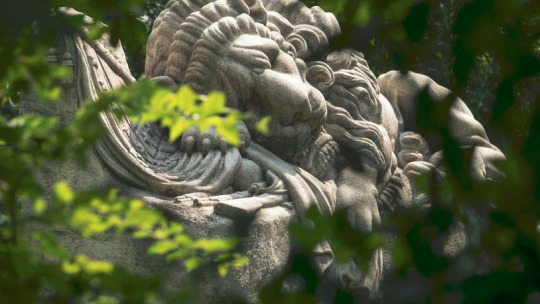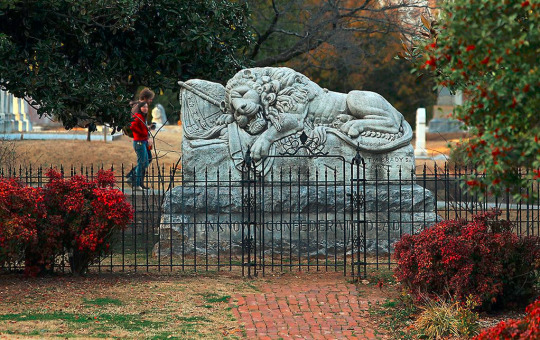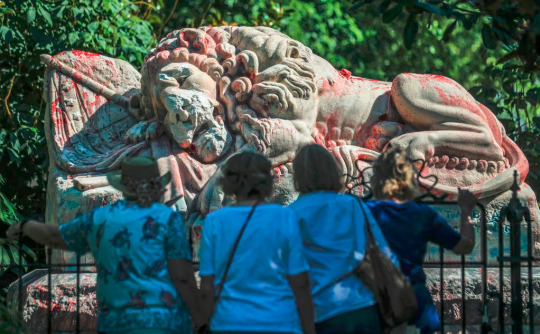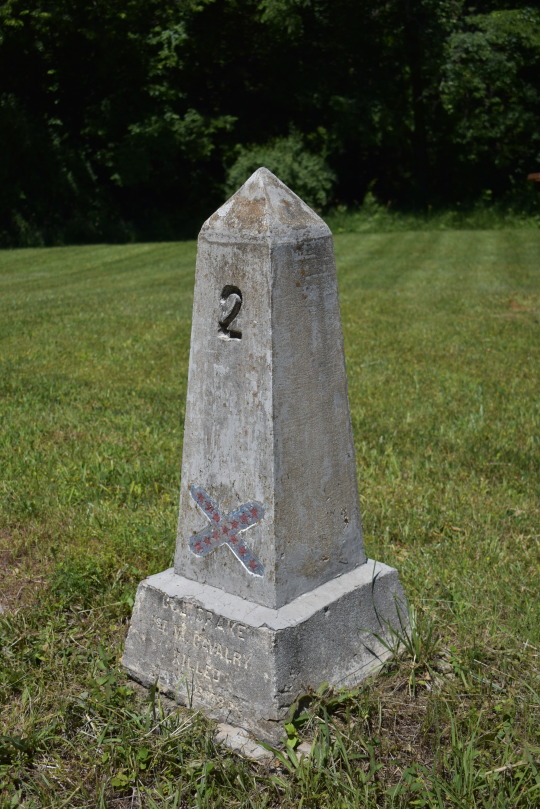#Confederate Obelisk
Explore tagged Tumblr posts
Text
I think that this is the funniest edition of TMBG's 2007 "Phone Calls From The Dead" segment that I have ever heard in which Linnell takes a "phone call" from Flansburgh pretending to be a dead person, who has retreated to backstage/offstage.
There are several other performances on YouTube that you could check out if you're unfamiliar. I will go into detail about this one after the cut, which exists so that you can listen to the recording before continuing. You should do that 🙌
Usually the "caller" is a celebrity, and this time Flans has chosen "Vince", who is apparently "buried under a giant rock at the center of town". The funniest part about the bit is the appearance that who was going to call in was not discussed beforehand, resulting in Linnell mostly having no idea what to say to this crazy helpless hippie-sounding sad sack. 😂
Flans is referring to an actual Asheville monument but it's Vance, not Vince (and nobody was ever buried there). The Vance Monument was a 75 foot tall obelisk that was completed in 1898 memorializing Zebulon Vance, a late nineteenth century governor of North Carolina and former Confederate soldier.

The monument was removed in 2021 in the aftermath of the murder of George Floyd and the BLM movement, due to Vance's connections to slavery and racist attitudes.
26 notes
·
View notes
Text
A Georgia square that was home to a Confederate monument for more than a century will now host a statue of the late civil rights icon John Lewis. Authorities began installing the sculpture of the former Georgia congressman in Decatur last week ahead of its official unveiling on Saturday. “It’s exciting to see it going up and exciting for the significance of what it represents and what it’s replacing,” Basil Watson, the artist behind the new statue, said at the installation. Its arrival comes about four years after Decatur officials removed a 30-foot-tall obelisk erected by the Daughters of the Confederacy in 1908. That statue was taken down in June of 2020, amid national racial justice protests that erupted across the U.S. following the murder of George Floyd in Minneapolis, Minn. Floyd, who was Black, died after a white police officer pressed his knee on Floyd's neck for more than 9 minutes as he lay facedown, hands cuffed behind his back.
11 notes
·
View notes
Text
Atlanta removing ‘Lion of the Confederacy’ statue from historic Oakland Cemetery

The city of Atlanta is set to remove a 127-year-old Confederate monument from Oakland Cemetery after it has repeatedly attracted vandals wielding sledgehammers and spray paint cans.
The City Council passed a resolution Monday evening declaring that the city should remove the “Lion of the Confederacy” monument and place it in temporary storage. The removal could happen as soon as this week, according to a member of City Council.
In recent years the statue has been defaced with graffiti, red latex and hit with objects like a pickaxe and sledgehammer.

The statue was built by T.M. Brady and dedicated on Confederate Memorial Day in 1894 to honor the 3,000 unknown Confederate dead resting in Oakland Cemetery. The statue depicts a wounded or dead lion with its right paw resting on a cannonball partially concealed by Confederate flag.
The lion’s removal follows years of discussion among city leaders about how to address contentious Confederate iconography in Atlanta. In 2017, then-mayor Kasim Reed signed off on a 40-page report written by an 11-member panel that included recommendations related to Confederate symbols in the city.ExplorePhotos: Confederate memorials in metro Atlanta
Among the recommendations was the renaming of Confederate Avenue in the Grant Park and Ormewood Park neighborhoods to United Avenue, and attaching contextual markers to monuments like the Lion of the Confederacy and a 65-foot-tall Confederate obelisk also located inside Oakland Cemetery.
What sets both objects apart from Confederate monuments that sit in front of courthouses, state capitols or on city streets is that they are not “in your face,” but are part of the statuary of the cemetery, said Sheffield Hale, president and CEO of the Atlanta History Center.
Carved from Georgia marble, the lion is modeled after the Lion of Lucerne in Lucerne, Switzerland — an 1821 sculpture memorializing the Swiss guards massacred during the French revolution. The 30-foot-long Swiss sculpture is carved into the face of a low cliff, and is considerably larger than the Oakland version.
Atlanta City Council member Carla Smith, a sponsor of the legislation to remove the lion, led the panel established by Reed and was a major force behind the contextual markers.
While the committee never recommended the removal of the lion, vandals have left the city little choice but to move it to an undisclosed location, Smith said.

“They’ve smashed the face, the nose is completely missing and the cost of trying restore it is becoming too much,” Smith said.
“There’s been this constant vandalism and constant drain on city resources trying to protect and restore it,” said Councilwoman Natalyn Archibong, whose district includes Oakland Cemetery.
Richard Harker, executive director of the Historic Oakland Foundation, said that since October 2019, the marker had been vandalized at least eight times and that the interpretive signage below the statue, including the contextual marker, had been defaced repeatedly, sometimes in broad daylight. City employees have spent 150 hours rehabbing the statue after instances of vandalism.
Harker said six permanent security cameras had recently been installed in the park, including a couple aimed directly at the lion. Extra security guards had been hired in the last several months to deter vandals.

“The city’s history is good, bad, ugly and beautiful, and the city has to wrestle with all those legacies so we can move forward,” Harker said. “This is another example of the city, in a sad, unfortunate way, of doing so.”
The City Council approved a $33,000 contract with Superior Rigging and Erecting Co. to remove the lion statue. The city has not said where it will be located long-term.
The Confederate statue is listed by the Smithsonian as a historically significant piece of funerary art, Hale said, but removing it is a matter of public safety as well as preservation.
Hale also mentioned that the tension associated with the sculpture could lead to violence “adjacent” to the statue.
In the years since the city’s report on Confederate iconography came out, local governments around the state and nation have taken steps to remove monuments that glorify the Confederacy amid widespread protests against racism. The Georgia state law that makes it difficult for local governments to relocate or remove Confederate monuments was also updated in 2019 to include language that allows for “appropriate measures for the preservation, protection and interpretation” of monuments.
The Confederate obelisk in downtown Decatur came down last June. A Confederate monument built in 1993 in Lawrenceville’s downtown square was removed earlier this year.
#Atlanta to remove ‘Lion of the Confederacy’ statue from Oakland Cemetery#lion of the confederacy#atlanta#confederacy#confederate monuments
5 notes
·
View notes
Text
The Washington Monument - Today In Southern History
6 December 1884 On this date in 1884�� Workers placed the 3,300 pound marble capstone on the Washington Monument, completing construction of the 555-foot Egyptian-styled obelisk in Washington D.C. Other Years: 1833 – Confederate Colonel and “Gray Ghost” John S. Mosby was born in Powhatan County, Virginia. 1865 The 13th Amendment to the United States Constitution abolished slavery. 1889 –…
0 notes
Text
A 12-foot-tall bronze statue of late civil rights leader and congressman John Lewis was unveiled Saturday at a city park in Georgia in the same spot as a contentious Confederate monument that was dismantled four years ago.

Lewis was known for his role at the front lines of the Civil Rights Movement and was a Democratic congressman from Georgia. He died in 2020 from pancreatic cancer.

The statue of Lewis stands in the same spot as a obelisk that was erected by the United Daughters of the Confederacy in 1908. It was removed in 2020 after the city of Decatur asked a Georgia judge to order the removal of the monument.

(📸 Getty images)
#allthenews
0 notes
Text
The Week in Confederate Heritage
An obelisk memorializing the U.S. Confederacy located on the grounds of the North Carolina Capitol remains partially intact Monday afternoon, June 22, 2020, in Raleigh, N.C. Crews have not yet fully removed the statue. (AP Photo/Bryan Anderson) This week we begin with this article from North Carolina. “From UNC-Chapel Hill’s campus to the lawn of the state capitol, to the historic Durham county…

View On WordPress
0 notes
Text
Events 2.21 (before 1950)
1076 – Having received a letter during the Lenten synod of 14–20 February demanding that he abdicate, Pope Gregory VII excommunicates Henry IV, Holy Roman Emperor. 1316 – The Battle of Picotin, between Ferdinand of Majorca and the forces of Matilda of Hainaut, ends in victory for Ferdinand. 1371 – Robert II becomes King of Scotland, beginning the Stuart dynasty. 1495 – King Charles VIII of France enters Naples to claim the city's throne. 1632 – Ferdinando II de' Medici, Grand Duke of Tuscany, the dedicatee, receives the first printed copy of Galileo's Dialogue Concerning the Two Chief World Systems. 1651 – St. Peter's Flood: A storm surge floods the Frisian coast, drowning 15,000 people. 1744 – War of the Austrian Succession: The Battle of Toulon causes several Royal Navy captains to be court-martialed, and the Articles of War to be amended. 1770 – British customs officer Ebenezer Richardson fires blindly into a crowd during a protest in North End, Boston, fatally wounding 11-year-old Christopher Seider; the first American fatality of the American Revolution 1797 – The last Invasion of Britain begins near Fishguard, Wales. 1819 – By the Adams–Onís Treaty, Spain sells Florida to the United States for five million U.S. dollars. 1847 – Mexican–American War: The Battle of Buena Vista: Five thousand American troops defeat 15,000 Mexican troops. 1848 – The French Revolution of 1848, which would lead to the establishment of the French Second Republic, begins. 1856 – The United States Republican Party opens its first national convention in Pittsburgh. 1862 – American Civil War: Jefferson Davis is officially inaugurated for a six-year term as the President of the Confederate States of America in Richmond, Virginia. He was previously inaugurated as a provisional president on February 18, 1861. 1872 – The Prohibition Party holds its first national convention in Columbus, Ohio, nominating James Black as its presidential nominee. 1879 – In Utica, New York, Frank Woolworth opens the first of many of five-and-dime Woolworth stores. 1881 – Cleopatra's Needle, a 3,500-year-old Ancient Egyptian obelisk is erected in Central Park, New York. 1889 – President Grover Cleveland signs a bill admitting North Dakota, South Dakota, Montana and Washington as U.S. states. 1899 – Filipino forces led by General Antonio Luna launch counterattacks for the first time against the American forces during the Philippine–American War. The Filipinos fail to regain Manila from the Americans. 1904 – The United Kingdom sells a meteorological station on the South Orkney Islands to Argentina; the islands are subsequently claimed by the United Kingdom in 1908. 1909 – The sixteen battleships of the Great White Fleet, led by USS Connecticut, return to the United States after a voyage around the world. 1921 – After Russian forces under Baron Roman von Ungern-Sternberg drive the Chinese out, the Bogd Khan is reinstalled as the emperor of Mongolia. 1942 – World War II: President Franklin D. Roosevelt orders General Douglas MacArthur out of the Philippines as the Japanese victory becomes inevitable. 1943 – World War II: Members of the White Rose resistance, Sophie Scholl, Hans Scholl, and Christoph Probst are executed in Nazi Germany. 1944 – World War II: American aircraft mistakenly bomb the Dutch towns of Nijmegen, Arnhem, Enschede and Deventer, resulting in 800 dead in Nijmegen alone.[ 1944 – World War II: The Soviet Red Army recaptures Krivoi Rog. 1946 – The "Long Telegram", proposing how the United States should deal with the Soviet Union, arrives from the US embassy in Moscow.
0 notes
Text
"In every city where a colonial or confederate monument stands there is an even stronger community who believe in building up a world where people can co-exist without the harsh reminders of violence perpetuated onto them."
The Kit Carson statue in #SanteFe, #NewMexico has been toppled for the second time in three years.
#new mexico#sante fe#class war#classwar#anti colonialism#anticonfederate#fuck the confederacy#confederate#confederate states of america#kitcarson#anti capitalism#anti slavery#anti colonization#fuck the gop#fuck the police#fuck the supreme court#fuck the patriarchy#ausgov#politas#auspol#tasgov#taspol#australia#neoliberal capitalism#fuck neoliberals#anthony albanese#albanese government#antiracism#antifascist#antifaschistische aktion
0 notes
Text
Tippecanoe Battlefield, Museum, Tippecanoe Indiana.
A national historic landmark, located in a 96-acre park setting in Battle Ground, complete with picnic areas, nature center, historic and scenic hiking trails. The 85-foot marble obelisk monument was erected in 1908 and marks the site of the November 7, 1811, Battle of Tippecanoe between the United States’ forces, led by William Henry Harrison, and representatives of Tecumseh’s Native American confederation.










0 notes
Photo





Jefferson County Confederate Obelisk #2 on Kearneysville Pike. It would be Col. James H. Drake of Fitz Lee’s Calvary brigade mentioned at the base. Killed 40ft to the west of the obelisk on July 16th 1863.
“On the Sixteenth, the Federals, crossing at Shepherdstown and driving in the pick- ets, advanced a large force of cavalry as far as Kearneysville. Here Fitz Lee and Chambliss' brigades of cavalry confronted them and steadily drove them back. The federals were amply supplied with artillery, and at every fav- orable position, made stubborn resistance. Late in the evening, Stuart came on the field and took command, having ordered General Jenkins, with his brigade of cavalry from near Martinsburg to his assistance, who arrived later in the evening. The enemy, having fallen back to Butler's woods, made a final stand. The cavalry could not well operate, and so both sides dismounted their men and fought until dark. The Confederates remained on the field, expecting to renew the engagement in the morning^ but the enemy moved off in the night. There is no official account of the losses on either side. Colonel Drake, of the first Virginia Cavalry, was mortally wounded, and died that night at Mr. Marshall's. About 40 feet from Marker No. 2, measuring west, is the place where he was shot. He was an able officer. This movement of the enemy had been made to ascer- tain Lee's position, but failed. This force was to have been supported by a brigade from Harpers Ferry, but they fail- ed to arrive on time, as will be shown. Company I>, of the Twelfth Virginia Cavalry, was picketing from near Shepherdstown to Engle's Hill; and when the advance was made, they stayed within the enemy's lines to operate. A courier was captured at Uvilla on the evening of the fifteenth, and sufficient information obtained to justify our watching this road. “
https://archive.org/stream/militaryoperatio00slpuiala/militaryoperatio00slpuiala_djvu.txt
#West Virginia#Kearneysville#Uvilla#Col Drake#1st Virginia Calvary#Col. James H. Drake#Fitz Lee's Calvary Brigade#James Drake#Confederate Col. James H. Drake#Confederate Soldier#Confederate Obelisk#Confederate Monument#obelisk#Civil War#American Civil War#Civil War Battle#My Photography#Photographers on Tumblr#Black and White Photography
3 notes
·
View notes
Text
I go back to work on site in a limited capacity next week (while the new covid infection rate still hasn't decreased more than 2 days in a row), and the mayor just put a curfew in place after the weekend's protests.
2020 continues to be a wild ride.
#hope the mayor can make good on a little promise he made regarding a certain Confederate obelisk or shit's going down#here's hoping some real positive change comes out of this year's awfulness
1 note
·
View note
Text
Remains of a Confederate monument removed from Jacksonville city park
2 notes
·
View notes
Photo
I love that the Washington Monument is 555 feet tall, which this person definitely knows, implying that it’d take roughly 2,220 people and a truly terrifying amount of chains to take it down, but she still feels the need to add that disclaimer of “please don’t tear down the big brick stick” because people are just pissed off enough they might actually try it. 😆






this is my new favorite Twitter thread
#look#im not saying id do it#im just saying#it was half built by slaves#and#holy shit#would it piss off trump#would definitely not be worth it#but#it would be in the spirit of 2020#IE#a raging continuous shitshow#american politics#egyptologist#side note#im low key convinced this egyptologist is just testing her theories on the american populace#‘a large number of people wanr to tear down confederate statues? fuck it. i want to test my obelisk theory’#‘might as well get a paper out of this shitshow...’
14K notes
·
View notes
Text
Storm nearly hits historic Confederate monument at Prison Site in Alton (IL)
Help Dixie Defeat Big-Tech Censorship! Spread the Word! Like, Share, Re-Post, and Subscribe! There’s a lot more to see at our main page, Dixie Drudge! Confederate Cemetery obelisk from 1909 escapes storm damage (The Telegraph) – A huge tree that fell from one of the recent storms came just 30 feet from hitting the 57-foot-tall obelisk at the Confederate Cemetery on Rozier Street. The tree broke…

View On WordPress
0 notes
Text
Confederate obelisk removed from Georgia square amid cheers - Fri, 19 Jun 2020 PST
With hundreds of people watching as midnight approached, a crane moved in and took down a Confederate monument that stood in the town square of an Atlanta suburb since 1908. Confederate obelisk removed from Georgia square amid cheers - Fri, 19 Jun 2020 PST
0 notes
Note
Thought: Saying that pro-confederate civil war "memorials" should be destroyed instead of put in a museum is like saying Mein Kampf should be burned instead of in the library. Like no, these things are not nice, but keeping them where we can find them for educational purposes doesn't mean we agree with them.
I agree that pretending parts of the past never happened is not a good way to handle things, but I’m skeptical that the physical statues are necessary for educational purposes. What exactly can you learn about a historical figure from a statue that couldn’t be better learned another way? Not to mention that on a logistical level they require much more space to store and to view than books (especially as nearly all books can be digitized and retain their value.) There might well be a place in museums for these, but it makes more sense for it to be an art museum than a historical museum.
I think if I were somehow unilaterally in charge of these things, I would replace the statues but also have a sign or plaque at each site about the history of the old statue— not just the figure depicted, but when and why the statue itself was erected and then taken down, because that’s where the historical value lies.
*Note: I wrote out most of this before realizing that it also makes a big difference whether we’re talking about something like “Obelisk With Names of the Fallen, 1870” vs. “General Famous McRacist Riding a Horse, 1920”. I was primarily thinking of the latter type in the last two paragraphs as these are more frequently challenged, but I would feel much more strongly about preserving the former even if that meant paying to relocate it. Both because of the whole “having information that might have been lost otherwise” and that, well, destroying something that was originally made out of personal loss (as opposed to hero-worship) doesn’t feel right, even if those being mourned died fighting for a horrendous “cause.” Whatever cemetery their contemporaries were buried in should be an appropriate place to keep that kind of memorial if no local museums want it.
6 notes
·
View notes